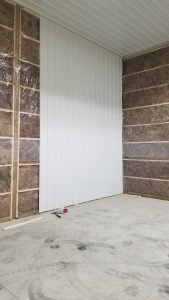TextraFINE® Post Frame Insulation
It is nice to hear from those who have read and learned from the articles I have posted over the past nearly three years. Even more rewarding, is when Hansen Pole Buildings’ team members come up with products for me to investigate.
Just today Justine (the Hansen Pole Buildings ordering and delivery wizard) asked me if I was familiar with “Textra fine” insulation. She had stumbled upon it during a web search and was unfamiliar with it, having always used either fiberglass or cellulose products previously.
Putting on my aluminum pyramid-shaped research hat, I jumped upon my trusty stead Internet and went on a search.
Anco TextraFINE® Post Frame insulation has excellent mechanical, thermal and acoustical properties making it ideal for insulating post frame structures where wide rolls of un-faced insulation are required.
 TextraFINE® Post Frame insulation is made from inorganic silica sand which is formed into long textile-type glass fibers which are bonded together in random orientation by a stable thermosetting binder. This process produces unusually strong, resilient insulation which will return to full thickness following compression.
TextraFINE® Post Frame insulation is made from inorganic silica sand which is formed into long textile-type glass fibers which are bonded together in random orientation by a stable thermosetting binder. This process produces unusually strong, resilient insulation which will return to full thickness following compression.
Manufactured with 85% post-industrial recycled content, TextraFINE® Post Frame Insulation can be a contributor to LEED® credits.
Standard sizes are six inches thick by 48” or 93” in width.
Basically the product (in its 93” width) is designed to friction fit between columns spaced every 8’. The idea being with 6×6 or 3 ply 2×6 laminated columns, and wall girts placed flat on the exterior of the posts, the six inch thick insulation will not extend inside the columns.
Before the International Building Codes were adopted, this would not have been a challenge, however to be Code conforming under the now enacted deflection criteria for wall girts – it IS a problem.
To find out more about deflection in wall girts: https://www.hansenpolebuildings.com/blog/2012/03/girts/
The structural framing solution, most often places framing in conflict with the installation of these wide insulation rolls.
TextraFINE® is also available as a Condensation Control Blanket (CCB) in standard one and two inch thick rolls. The average (or above average) installer or DIYer might want to think twice about this method of trying to control condensation by reading: https://www.hansenpolebuildings.com/blog/2011/11/metal-building-insulation-in-pole-buildings-part-i/
My take on TextraFINE® insulation? It is very probably a great insulation product, however the product as designed to be applied, may not always provide the best or most practical design solution. As more jurisdictions become savvy to the new code, it would behoove companies such as TextraFINE® to produce insulation in a size conducive to fitting between girts. Also having a vapor barrier would afford it more advantages.






